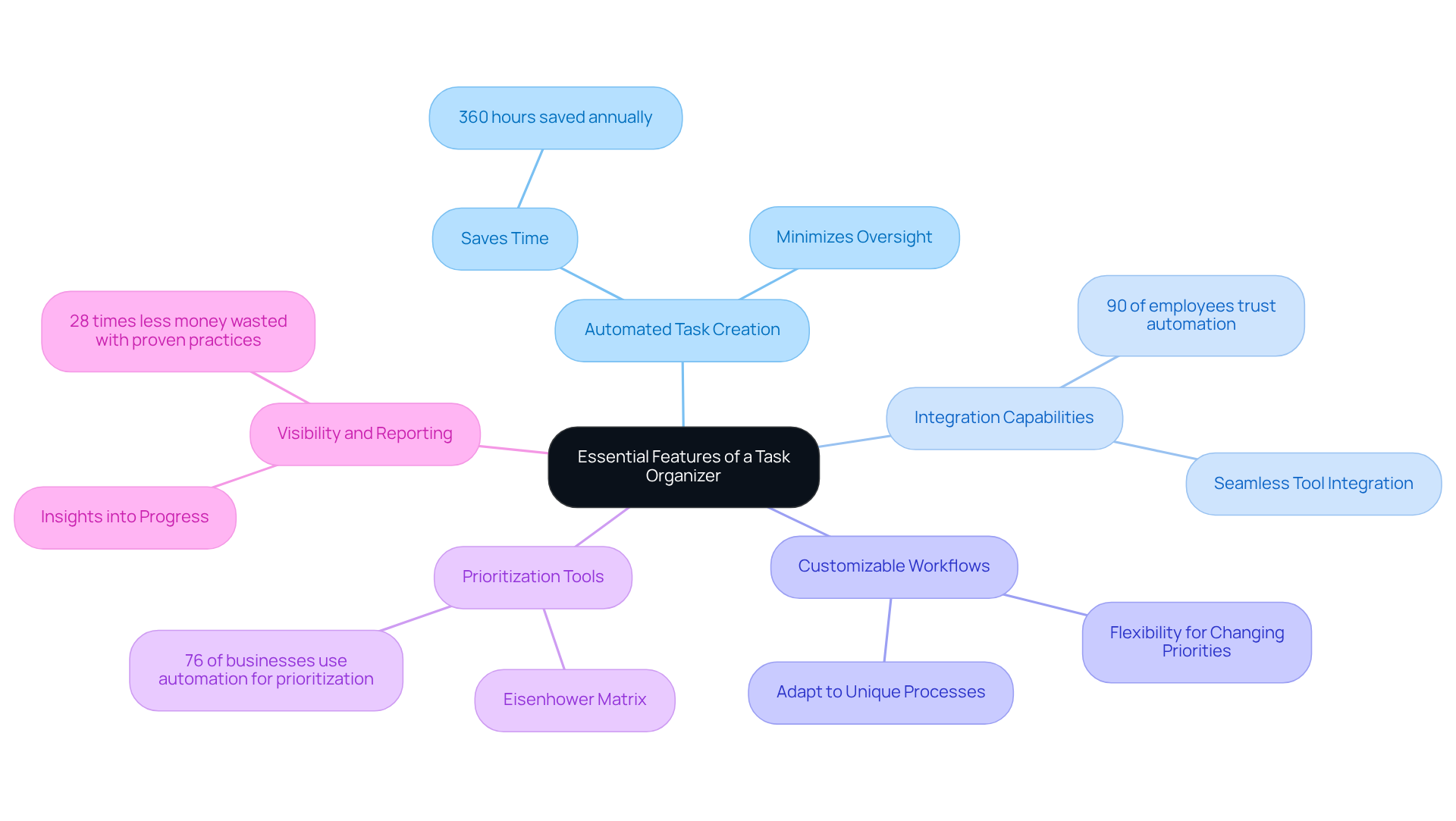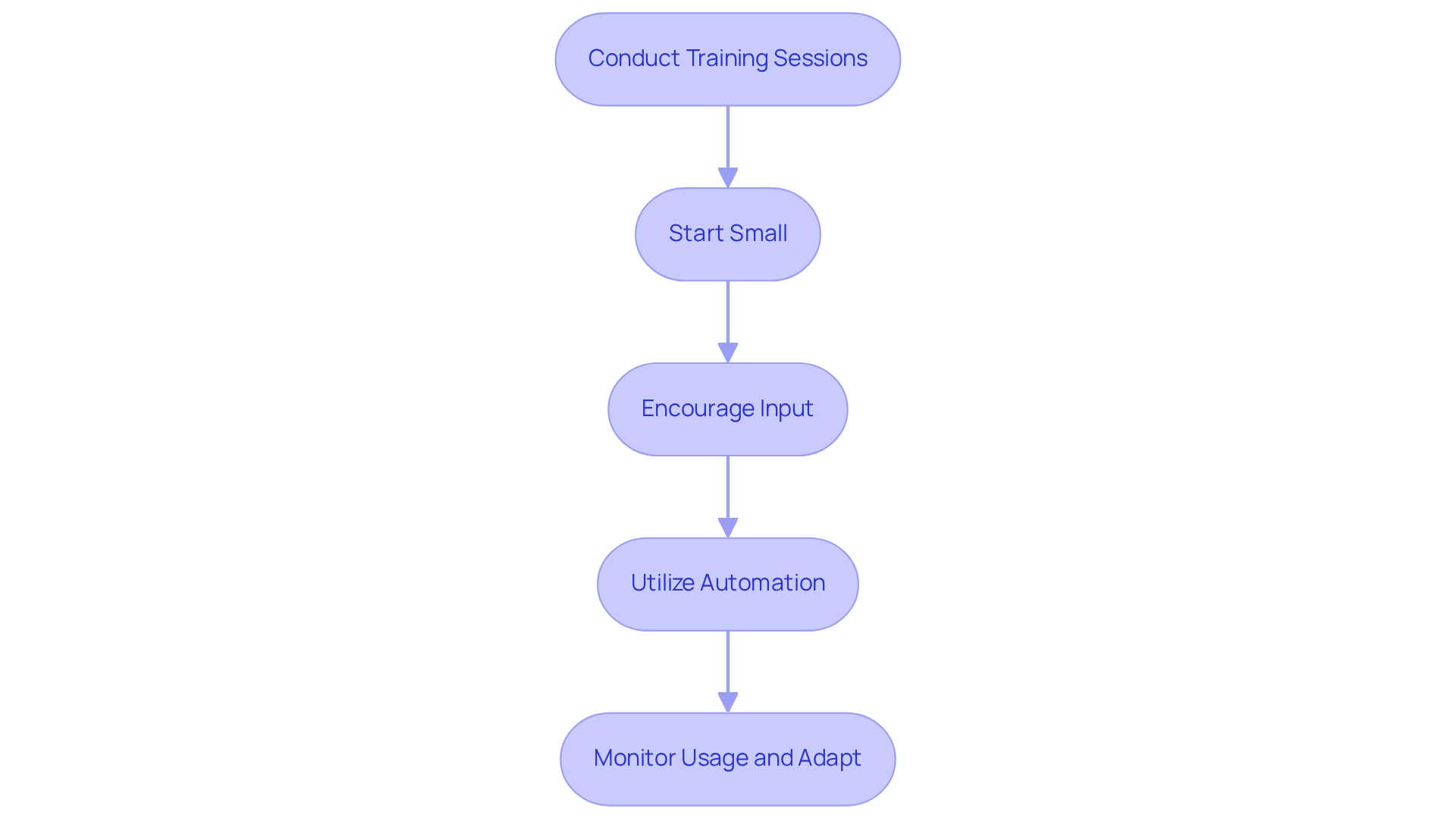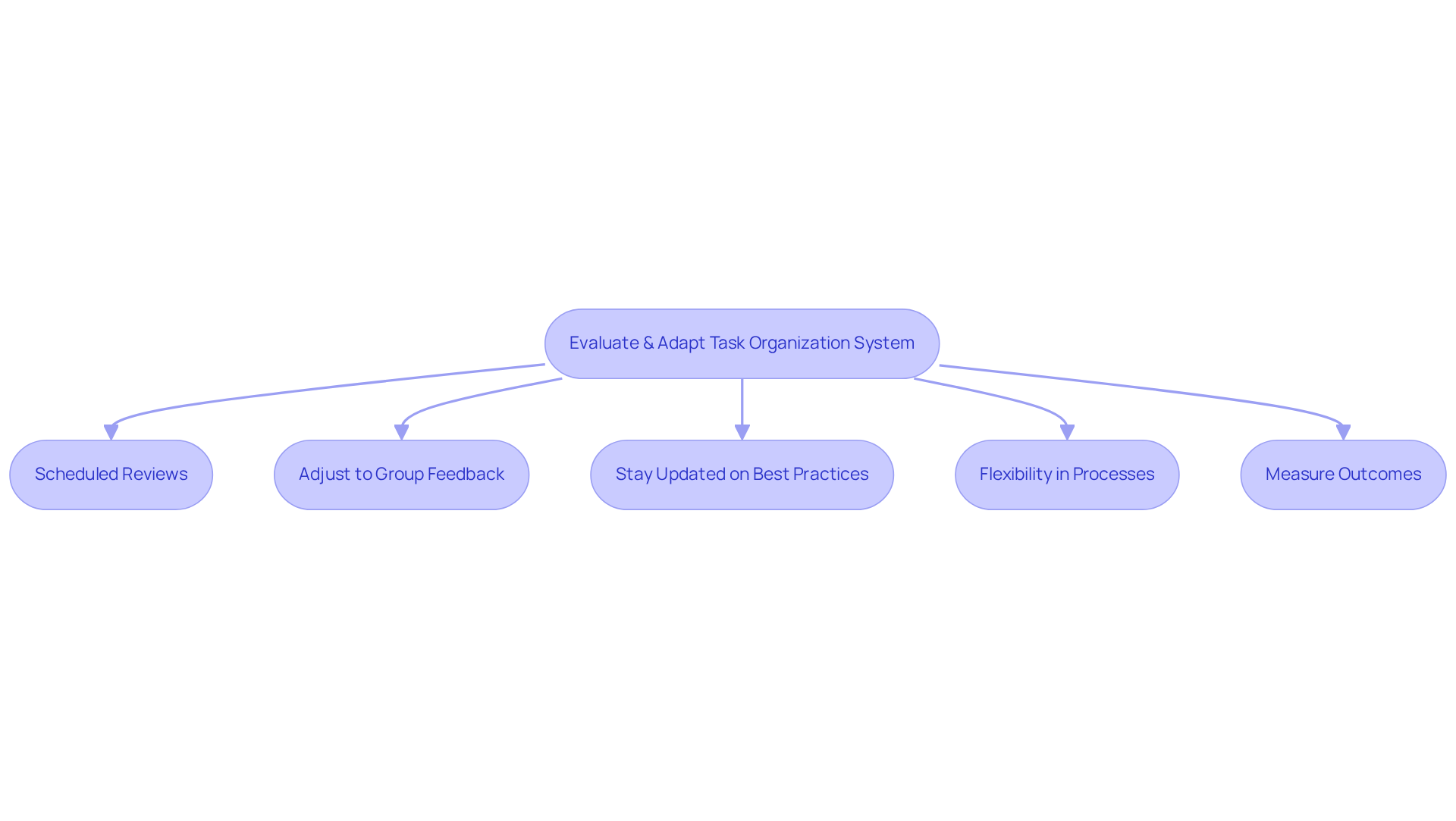Overview
This article highlights four essential practices for effectively utilizing a task organizer in startups, underscoring the critical role of structured task management in boosting efficiency and adaptability. It outlines key features such as:
- Automated task creation
- Integration capabilities
- Customizable workflows
- Prioritization tools
These elements collectively support the assertion that a well-implemented task organizer can markedly enhance team collaboration and overall productivity within a startup environment.
Are you struggling with task management in your startup? Understanding how to leverage these features can transform your team's workflow. By adopting a task organizer, you not only streamline operations but also foster a more collaborative atmosphere. The integration of automation and customization empowers teams to focus on what truly matters, driving success in a competitive landscape.
In conclusion, the implementation of a task organizer is not merely a choice; it is a strategic decision that can lead to significant improvements in productivity and collaboration. Take action today to explore how these tools can elevate your startup to new heights.
Introduction
In the fast-paced world of startups, where every second counts and resources are often stretched thin, effective task organization can be the difference between success and failure. By implementing a structured approach to managing responsibilities, startups can significantly enhance their operational efficiency, foster collaboration, and empower their teams. However, many entrepreneurs grapple with how to effectively integrate these organizational tools into their workflows.
What key practices can transform a simple task organizer into a powerhouse for productivity and growth?
Understand the Importance of Task Organization in Startups
In the dynamic landscape of startups, where resources are often limited and time is of the essence, a task organizer is essential for the effective organization of activities and stands as a cornerstone of operational success. Have you considered how explicitly outlining duties and responsibilities can reduce confusion and ensure that all individuals are aligned toward shared objectives? A task organizer facilitates structured activities that not only optimize workflows but also enhance accountability, enabling group members to easily monitor progress and identify bottlenecks. Furthermore, a well-organized task organizer in project management fosters a culture of openness, promoting improved communication and collaboration among team members.
Startups that prioritize the organization of responsibilities are better equipped to pivot swiftly in response to market shifts, ultimately leading to enhanced agility and creativity. Real-world examples illustrate this point: new businesses that have implemented robust organization systems report higher employee satisfaction and retention rates, as team members feel more empowered and engaged in their work. Recognizing the significance of a task organizer allows startups to lay the groundwork for lasting growth and achievement. How can your startup benefit from a more organized approach to project management?

Identify Essential Features of a Task Organizer for Startups
When selecting a project planner, startups must prioritize elements that enhance efficiency and flexibility. Key functionalities to consider include:
- Automated Task Creation: An organizer capable of automatically generating tasks from conversations or project discussions not only saves time but also minimizes the risk of oversight. Research indicates that companies can save approximately 360 hours annually through process automation, highlighting its significant impact on efficiency.
- Integration Capabilities: Seamless integration with existing tools like Slack or Telegram is crucial for maintaining workflow continuity and minimizing disruption. Nearly 90% of employees trust automation solutions to deliver error-free results, underscoring the necessity of reliable integrations.
- Customizable Workflows: Customizable workflows in a task organizer are essential, as startups often have unique processes that require customization to meet specific team needs. Flexibility in workflows is vital, enabling teams to adapt swiftly to changing priorities.
- Prioritization Tools: Features such as the Eisenhower Matrix or OKRs help teams focus on what matters most, ensuring that critical tasks are addressed promptly. This aligns with findings that 76% of businesses utilize automation for standardizing or automating daily workflows, reinforcing the importance of effective prioritization.
- Visibility and Reporting: A competent project manager should provide insights into activity progress and team performance, facilitating data-informed decision-making. Organizations that invest in proven project management practices waste 28 times less money, emphasizing the value of visibility in enhancing operational efficiency.
By focusing on these essential attributes, new ventures can select a task organizer who not only meets their current needs but also adapts to their growth.

Implement Strategies for Seamless Integration of Task Organizers
To achieve seamless integration of a task organizer, startups should consider the following strategies:
- Conduct Training Sessions: Providing comprehensive training for team members on how to use the task organizer effectively can significantly enhance adoption rates.
- Start Small: Begin with a pilot project or a small group to test the system's effectiveness before implementing it throughout the company. This approach allows for adjustments based on feedback.
- Encourage Input: Establish avenues for group members to share their experiences and recommendations concerning the activity coordinator. This feedback loop can help refine usage and address any issues early on.
- Utilize Automation: Leverage automation features to minimize manual input and streamline processes. For instance, establishing automated reminders for deadlines can keep the group on track without added effort.
- Monitor Usage and Adapt: Regularly evaluate how the activity planner is being utilized and implement necessary modifications to workflows or features to better accommodate the team's evolving requirements.
By employing these strategies, new ventures can ensure that their task organizer is effectively incorporated into daily operations, resulting in enhanced productivity and decreased operational overhead.

Evaluate and Adapt Your Task Organization System Regularly
To ensure a project organization system remains effective, startups must commit to regular evaluations and adaptations. This can be achieved through:
- Scheduled Reviews: Allocate time on a monthly or quarterly basis to assess the performance of the task organization system. What is working well? What needs improvement?
- Adjust to Group Feedback: Actively seek input from team members regarding their experiences with the task organizer. Their insights can provide valuable information on areas requiring adjustment. As Darius Foroux states, "When I discuss productivity, I refer to effectiveness," highlighting the importance of aligning activity management with team needs.
- Stay Updated on Best Practices: Remain informed about industry trends and best practices in project management. This knowledge can guide essential modifications to the organization system. For instance, studies indicate that multitasking can diminish productivity by as much as 50%, underscoring the necessity for focused management of activities.
- Flexibility in Processes: Be prepared to pivot and adapt workflows as the startup evolves. A rigid organization system can stifle progress and innovation.
- Measure Outcomes: Utilize metrics to evaluate the efficiency of the activity organization system. Tracking key performance indicators (KPIs) can help identify areas for improvement and validate the impact of changes made. Casy, for example, offers tools that can automate this tracking process, allowing new businesses to focus on their core activities while minimizing administrative overhead.
By regularly evaluating and adapting their task organizer system, startups can ensure it continues to meet their needs and supports their growth trajectory. However, it is crucial to remain aware of common pitfalls, such as resistance to change or neglecting team feedback, which can undermine these efforts.

Conclusion
In the fast-paced environment of startups, effective task organization emerges as a critical element for success. By implementing a structured approach to managing responsibilities, startups can enhance collaboration, improve accountability, and foster a culture of transparency. This foundational practice not only streamlines workflows but also empowers teams to respond swiftly to changes, ultimately positioning the organization for sustainable growth.
The article highlights four key practices that startups should adopt when utilizing a task organizer:
- Understanding essential features such as automated task creation
- Integration capabilities
- Customizable workflows
- Prioritization tools
Furthermore, strategies for seamless integration—like conducting training sessions and encouraging team feedback—are crucial for ensuring that the task organizer becomes an integral part of daily operations. Regular evaluations and adaptations of the task organization system are also necessary to keep it aligned with the evolving needs of the team.
Embracing these practices not only enhances operational efficiency but also cultivates a more engaged workforce. Startups are encouraged to take action by prioritizing task organization and continuously refining their systems. By doing so, they can unlock their full potential, navigate challenges more effectively, and ultimately drive their vision forward with greater clarity and purpose.
Frequently Asked Questions
Why is task organization important in startups?
Task organization is crucial in startups due to limited resources and time constraints. It helps outline duties and responsibilities, reduces confusion, and ensures alignment towards shared objectives.
How does a task organizer enhance accountability in a startup?
A task organizer facilitates structured activities, allowing group members to easily monitor progress and identify bottlenecks, which enhances accountability among team members.
What impact does a well-organized task management system have on team communication?
A well-organized task management system fosters a culture of openness, promoting improved communication and collaboration among team members.
How do organized responsibilities affect a startup's agility and creativity?
Startups that prioritize the organization of responsibilities can pivot swiftly in response to market shifts, leading to enhanced agility and creativity.
What benefits do startups experience from implementing robust organization systems?
Startups that implement robust organization systems report higher employee satisfaction and retention rates, as team members feel more empowered and engaged in their work.
What is the long-term significance of a task organizer for startups?
Recognizing the significance of a task organizer allows startups to lay the groundwork for lasting growth and achievement.




